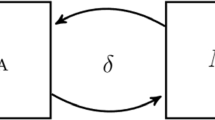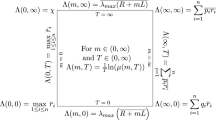Abstract
The effect of dispersal on the permanence of population in a polluted patch is studied in this paper. The authors constructed a single-species dispersal model with stage-structure in two patches. The analysis focuses on the case that the toxicant input in the polluted patch has a limit value. The authors derived the conditions under which the population will be either permanent, or extinct.
Similar content being viewed by others
References
Aiello, W.G., Freedman, H.I. A time delay model of single–species growth with stage structure. Math. Biosci, 101:139–152 (1990)
Berreta E., Takeuchi, Y. Global asymptotic stability of Lotka–Volterra diffusion models with continuous time delays. SIAMJ. Appl. Math., 48:627–651 (1988)
Cui, J., Chen, L., Wang, W. The effect of dispersal on population growth with stage–structure. Computers Math. Applic., 39:91–102 (2000)
Freedman, H.I. Single species migration in two habitats:persistence and extinction. Mathl. Modelling, 8:778–780 (1987)
Freedman, H.I., Takechi, Y. Predator survival versus extinction as a function of dispersal in a predator–prey model with patchy environment. Nonli. Anal., 13:993–1002 (1989)
Hirsh, M.W. The dynamical systems approach to differential equations. Bull. A.M.S., 11:1–64 (1984)
Lancaster, P., Tismenetsky, M. The Thoery of Matrices, second edition. Academic Press, Orlando, 1985
Leung, A. Limiting behavior for a prey–predator model with diffusion and crowding effects. J. Math. Biol., 6:87–93 (1978)
Lu, Zhengyi, Takechi, Y. Permanence and global stability for cooperative Lotka–Volterra diffusion systems. Nonli. Anal., 10:963–975 (1992)
Mahbuba, R., Chen, L.S. On the non–autonomous Lotka–Volterra competition system with diffusion. Differential Equations and Dynamical System, 2:243–253 (1994)
Rothe, F. Convergence to the equilibrium state in the Volterra–Lotka diffusion equations. J. Math. Biol., 3:319–324 (1976)
Skellam, J.D. Random dispersal in theoretical population. Biometrika, 38:196–218 (1951)
Takechi, Y. Cooperative system theory and global stability of dispersal models. Acta Appl. Math., 14:49–57 (1989)
Wang, W., Chen, L. Global stability of a population dispersal in a two–patch environment. Dynamical Systems and Applications, 6:207–216 (1997)
Author information
Authors and Affiliations
Corresponding author
Additional information
Supported by the National Nature Science Foundation of China (Grant No. 10171099).
Rights and permissions
About this article
Cite this article
Yu, Yg., Zhang, Sc. & Yang, Zz. The Effect of Dispersal on Population Growth with Stage-structure. Acta Mathematicae Applicatae Sinica, English Series, English Series 19, 499–504 (2003). https://doi.org/10.1007/s10255-003-0126-y
Received:
Revised:
Published:
Issue Date:
DOI: https://doi.org/10.1007/s10255-003-0126-y




